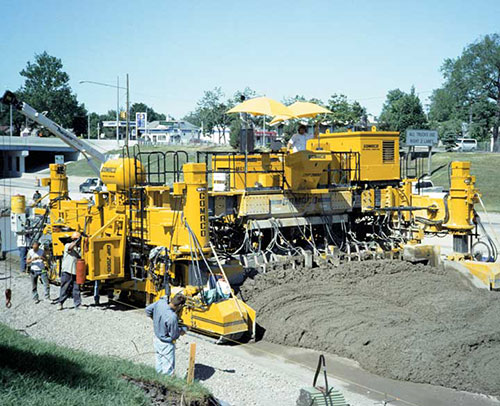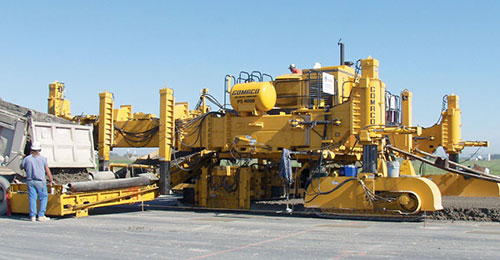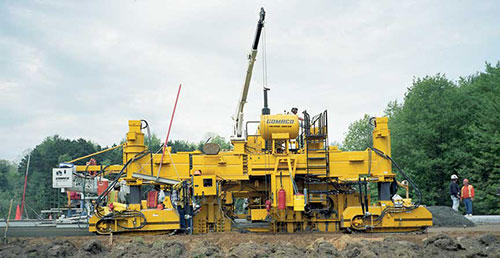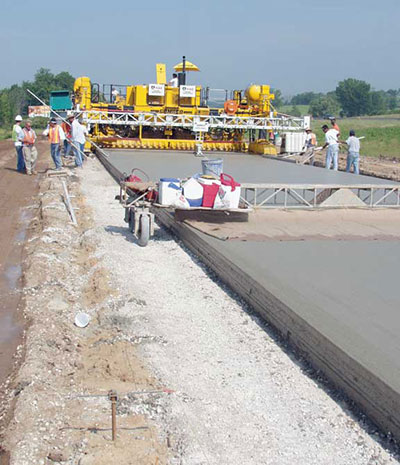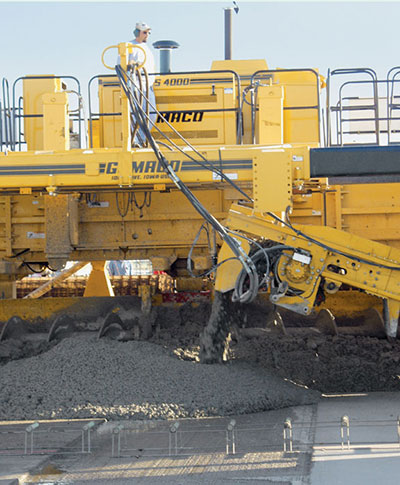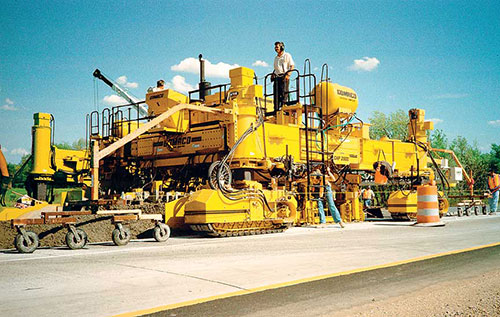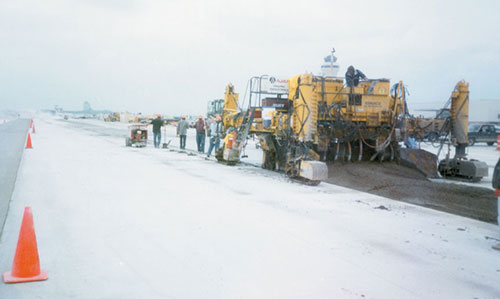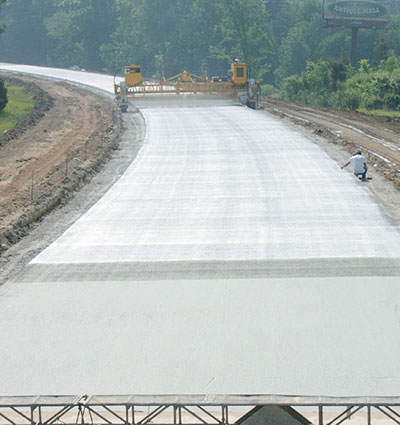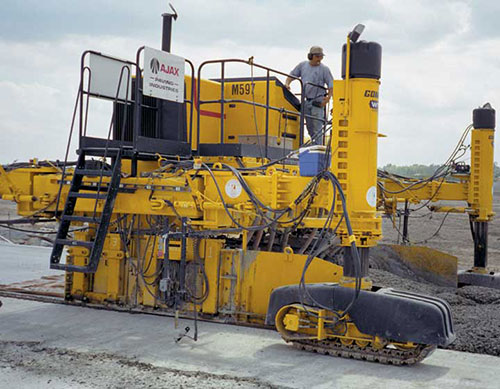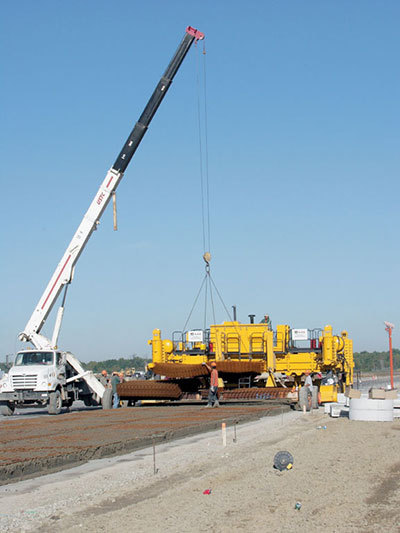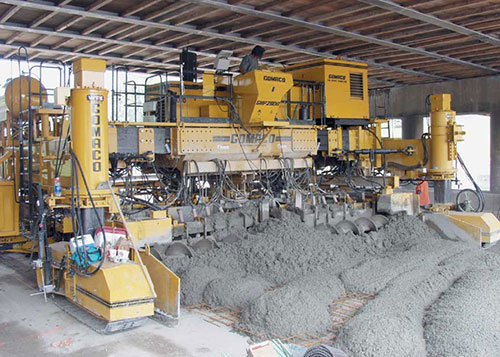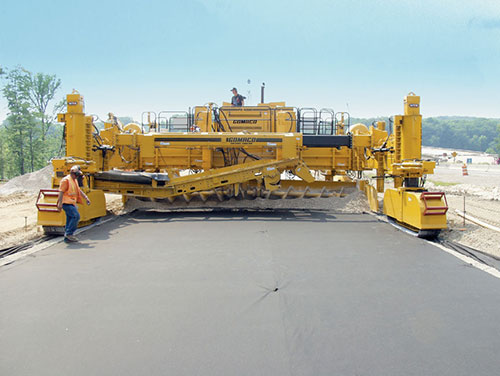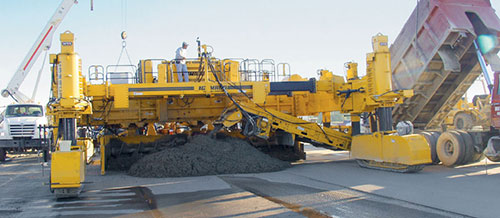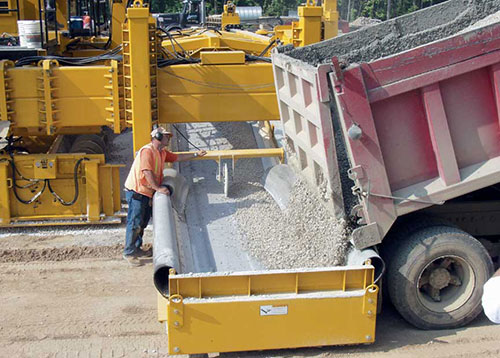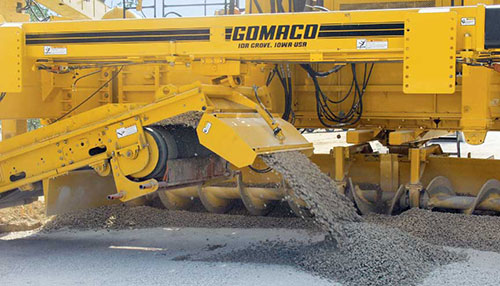GOMACO World Index --- GOMACO World 30.2 - April 2002
Massive Road and Airport Projects Push New and Old Technology To The Limit
Ajax Paving Industries, headquartered in Madison Heights, Michigan, isn't afraid of tackling monster projects. They thrive on difficult paving scenarios and look for innovative equipment to help them conquer the challenges. Their search for quality concrete equipment led them to GOMACO 13 years ago.
"Ajax is truly part of the GOMACO family. We enjoy doing business with them," Paul Selesky, Operations Manager for Ajax Paving Concrete Division, said. "Anybody can sell equipment, but GOMACO offers both product and technical support and that is a benefit. It's one of GOMACO's greatest advantages over its competitors."
Their paving equipment inventory includes two GP-3000 pavers (one of which paved 50 miles (80.47 km) of roadway just in 2000), two GHP-2800s (one of the first to be equipped with the In-The-Pan Dowel Bar Inserter), a GP-2600, a Commander III, a new generation Commander III, two PS-60 placer/spreaders, two T/C-600 texture/cure machines, and a 9500 trimmer/placer.
"The word partnership keeps coming to mind when I think of the relationship we have had with Ajax through the years," Brad Barkema, GOMACO's district representative, said. "It has been a great partnership for GOMACO with everyone at Ajax and with Tom Wietor and everyone at Wolverine Tractor and Equipment Company, who is our distributor. It's been a pleasure for all of us to work together and watch the growth of the Ajax concrete paving division."
They are the first in the United States to own the new PS-4000 placer/spreader built to place both aggregate base and concrete.
"The initial focus for a new placer/spreader was that we wanted a machine that could easily place aggregate base wide enough for the paving spread's trackline, then be able to easily and quickly change the placement width to use it the next day for concrete paving," Selesky explained.
Ajax put their new PS-4000 to work on several massive projects including the Detroit Metropolitan Wayne County airport expansion. Metro airport expansion not only consisted of the four-year construction of the Northwest Midfield Terminal, but also included the only new runway completed in the USA in 2001, a parallel taxiway, an adjacent taxiway, many hold aprons, remote de-icing pads and the new access road servicing traffic between terminals. All of Ajax's pavers were used on these projects at some time. During peak production, three batch plants were utilized to maintain the expedited schedule.
The Northwest Midfield project was a joint venture between Dan's Excavating, Inc., and Ajax Paving Industries, Inc. Dan's Excavating did the land balancing, utilities and most of the grade preparation. That preparation included placing a 16 inch (406 mm) dense graded limestone aggregate base. Ajax trimmed the aggregate base and then Ajax's Asphalt Division installed nine inches (229 mm) of bituminous concrete. Baskets were placed on grade at 50 foot (15.24 m) spacing.
The GOMACO PS-4000 placer/ spreader applied the first layer of concrete. Behind it, a wire mesh was laid on top of the concrete with the PS-60 applying another layer of concrete over the mesh reinforcing followed by a GP-3000.
The concrete pavement cross section on the Metro airport expansion including the Midfield project is 17 inches (432 mm) thick and the taxiways and runway include steel reinforcement. Depending on their location, the length of the pours varied up to 4500 feet (1372 m).
The runway was slipformed in six 25 foot (7.62 m) lanes for a total width of 150 feet (45.72 m). Each of the lanes was 10,000 feet (3048 m) long. The taxiways were slipformed in three 25 foot (7.62 m) lanes for a total width of 75 feet (22.86 m) wide and varied in length.
"The PS-4000 was certainly beneficial in spreading low slump concrete, 10 yd3 (7.65 m3) were placed as quick as the truck could raise its box," Selesky said. "The load is dumped and another truck moves into position as the PS-4000 spreads the concrete. When you're paving 17 inches (432 mm) thick and 25 feet (7.62 m) wide, one truck doesn't go very far."
A female keyway was molded on both sides of the 25 foot (7.62 m) slab by the paver and sidemounted bar inserters installed .75 inch (19 mm) by 30 inch (762 mm) long lane tie bars on 12 inch (305 mm) centers.
Working in the wide-open spaces on this project led to some impressive production figures, one that included a new company best.
"We beat our one-day record on Taxiway Q. In a 13-hour day we poured 7,960 yd3 (6086 m3)," Leo Remijan, project superintendent, said. "We did several days back-to-back that were more than 4500 yd3 (3440 m3) in a 10-hour period."
"The edge slump was a real critical issue," Selesky said. "With consistent mud, we were able to use the GOMACO pavers and their hydraulic over-builds to maintain a smooth and straight edge."
Approximately 500,000 yd3 (382,277 m3) of concrete was placed at the Metro airport project. It is the largest project Ajax has completed so far in their company's history.
Managing a project of that magnitude takes a lot of coordination and planning.
"On the Midfield, there were so many different areas that we were working on at the same time," Remijan explained. "Ajax employs three paving crews, making it possible to place 1000 to 1500 yd3 (765 to 1147 m3) of concrete in three different locations on the same day. The most difficult task was truck coordination."
The second largest concrete project to date for Ajax Paving is the new M-6 South Beltline Freeway on the south side of Grand Rapids, Michigan. The project began with the reconstruction of I-96, a divided freeway which consisted of two lanes in each direction, and an interchange consisting of four ramps.
The PS-4000 was originally purchased for this project. Ajax looked for one machine to place both stone and concrete, as well as having a fast tracking speed for job-site mobility.
Ajax re-used the existing Class-2 granular base, put a geotextile fabric down over it, and then brought in the PS-4000 to place four inches (102 mm) of open-graded material.
"Crews placed stone at 3000 feet (914 m) per day at a width of 29 feet (8.84 m)," Hugh Luedtke, project manager, said. "Once we placed the open graded aggregate base, we then backed up the PS-4000, changed the width of the pan, and were ready for concrete paving. Tracking these machines around job sites is one of the driving forces for having that faster track speed."
The PS-4000 led the Ajax paving train on the M-6 project. A PS-60 placer/spreader followed and applied the second layer of concrete for a total thickness of 10.25 inches (260 mm). A GHP-2800 four-track paver followed the placer/spreaders, while the T/C-600 texture/cure applied a tine finish to the new roadway. Joints were cut every 14.75 feet (4.5 m).
"This year we'll start constructing the US-131/M-6 interchange which is a reinforced concrete job," Selesky said. "Once again, the PS-4000 will place the stone base. Our paving train will consist of the PS-4000, a PS-60, a GHP-2800, and a texture/cure machine. It will definitely be a GOMACO show."
Even though the project is Ajax's second largest, it's not their most interesting one from the past year. According to Luedtke, the challenges they faced on US-131 north of Grand Rapids make a better story.
"The overlay job in Michigan is the concrete paving industry's answer to competing with asphalt projects," Selesky said.
"The job was a two-year, seven mile (11.27 km) project. We overlaid two driving lanes and the existing asphalt shoulders with concrete," Luedtke said. "A one inch (25 mm) asphalt bond-breaker was applied to the existing roadway. Then, a concrete overlay of a nominal seven inches (178 mm) was placed."
The project required that at least one lane of traffic remain open at all times and no traffic crossovers were allowed. Ajax was basically working in traffic.
The first phase consisted of placing the asphalt bond breaker on the existing travel lanes and shoulders, then placing the traffic on the shoulder. The 12 foot (3.6 m) driving lane with ten foot (3.05 m) shoulder was constructed. The second phase of the project required moving live traffic to the newly constructed lane and shoulder and adding on a new 12 foot (3.66 m) lane with four foot (1.22 m) shoulder.
"That's why we weren't allowed any crossovers, because it was to be done in the same manner that the asphalt industry would have to construct the job," Luedtke explained.
The first year of the project, Ajax used their GP-3000 paver and manually placed the load transfer baskets. The variable thickness of the pavement required the use of several different size baskets.
"Coordination and delivery of the proper sized baskets was a critical procedure," Luedtke explained.
The paver was set at 22 feet (6.7 m) wide to slipform a 12 foot (3.66 m) driving lane with ten foot (3.05 m) shoulder.
The next year, Ajax brought in their new GHP-2800 paver equipped with the In-The-Pan Dowel Bar Inserter (IDBI), with a Minnich Auto-2 vibrator monitoring system. Placing the dowels in the variable thickness pavement could have been a challenge, but the IDBI handled the insertion process with ease.
"Placing dowels on the run while variably changing the depth of the bar placement was an integral part of the job," Selesky explained. "It worked out well with the IDBI. Our bar placement was excellent and the owner, MDOT, was very satisfied."
The average depth of the concrete was 7.5 inches (191 mm). It would increase in transitional areas and full super-elevation sections.
"At times it was necessary to place over two feet (0.61 m) of concrete on the outside edge, to correct the super- elevation sections," Luedtke explained.
The changes in depth and bar placement were monitored by Ajax and the Michigan Department of Transportation (MDOT). GOMACO has designed special software to allow smooth transitions and the power transition adjuster (PTA) in the front pan, the IDBI and the finishing pan are all synchronized to make the necessary adjustments as they reach specific stations in the transition.
The computer can also be pre-programmed to skip bar insertion to allow for expansion or other joints.
"The project required a maximum 13 foot (3.96 m) joint spacing," Luedtke said. "As the paver approached a pre-placed expansion joint, it was a simple process for the operator to override the program, skip the joint and restart the IDBI settings."
It's amazing the difference a year can make with the purchase of new equipment. Ajax experienced a dramatic increase in production with their new IDBI.
"The previous year, we used a GP-3000 and set baskets. The next year, with the IDBI, we increased our production approximately 47 percent," Luedtke said. "Take a look at the job. The location of the haul road was the travel lane and getting trucks in and out as quick as possible was our priority. With the IDBI, we didn't worry about setting baskets and everything could be done on the fly. The IDBI is the only way to go."
"Production was a big concern originally when buying the paver," Selesky explained. "Would the IDBI be able to consistently pave at least 16 feet (4.88 m) a minute? We discovered the IDBI cycle, at times, can pave faster than that."
The accuracy of the bar placement is tested often and Ajax has had excellent results. Depth of the bars and consolidation around them is carefully checked.
"Typically at night, we would construct two to three test headers that we'd place dowel bars in," Luedtke explained. "The dowel bars were 1.24 inches (32 mm) in diameter and 18 inches (457 mm) long. Cuts were made two to three inches (51 to 76 mm) from either end to expose the bars so placement and consolidation could be checked. Results from our tests consistently passed all MDOT requirements."
Selesky added, "After observing the quality and productivity on this project, some MDOT personnel have come to realize that dowel bar insertion is superior to any type of manual basket setting operation."
"Based on our past and present relationship with GOMACO, I am confident that the future growth and success of our company will be greatly assisted by the GOMACO family," Mark Johnston, vice president of Ajax Paving Industries, Inc., said.
Editor's Note: GOMACO would like to dedicate this article to the memory of Herb Jacob, founder and chairman of Ajax Paving Industries. He passed away March 1, 2002.
His vision, strength and business knowledge built the influential company that Ajax is today. He was a true visionary and his presence and insight will be deeply missed.
Subscribe to Receive GOMACO World Magazine
